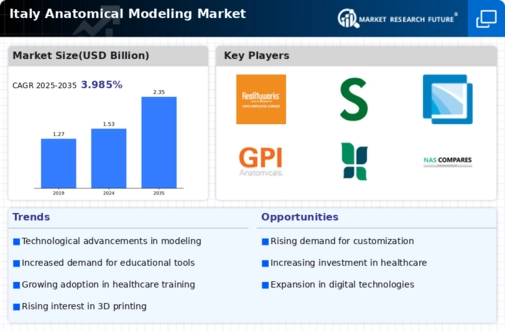Rising Demand for Medical Training
The anatomical modelling market in Italy experiences a notable surge in demand driven by the increasing need for effective medical training. As healthcare professionals seek to enhance their skills, educational institutions are incorporating advanced anatomical models into their curricula. This trend is reflected in the growing investment in medical education, with expenditures reaching approximately €1.5 billion in 2025. The anatomical modelling market is poised to benefit from this shift, as institutions prioritize realistic training tools that improve learning outcomes. Furthermore, the integration of 3D printing technology in creating anatomical models allows for tailored educational experiences, potentially increasing student engagement and retention rates. As a result, the anatomical modelling market is likely to see sustained growth as more institutions adopt these innovative training solutions.
Technological Integration in Healthcare
The integration of cutting-edge technology within the healthcare sector significantly influences the anatomical modelling market in Italy. With advancements in imaging techniques and 3D printing, the production of highly detailed anatomical models has become more feasible and cost-effective. This technological evolution is expected to drive market growth, as healthcare providers increasingly utilize these models for surgical planning and patient education. The anatomical modelling market is projected to expand as hospitals and clinics invest in high-quality models that enhance surgical precision and improve patient outcomes. In 2025, the market is estimated to reach a valuation of €300 million, reflecting the growing reliance on technology-driven solutions in medical practice. This trend suggests a promising future for the anatomical modelling market as it aligns with the broader digital transformation in healthcare.
Growing Awareness of Patient-Centric Care
The anatomical modelling market in Italy is increasingly influenced by the growing emphasis on patient-centric care. Healthcare providers are recognizing the importance of involving patients in their treatment processes, which has led to a demand for tools that facilitate better understanding of medical conditions. Anatomical models serve as effective communication aids, allowing patients to visualize their anatomy and treatment options. This trend is reflected in the rising adoption of anatomical models in clinical settings, with an estimated 40% of healthcare facilities incorporating them into patient consultations by 2025. The anatomical modelling market is likely to thrive as more providers seek to enhance patient engagement and satisfaction through the use of these educational tools. This shift towards patient-centric care may also drive further innovation in model design and functionality, aligning with the evolving needs of both patients and healthcare professionals.
Regulatory Support for Medical Innovations
The anatomical modelling market in Italy is positively impacted by the supportive regulatory environment for medical innovations. The Italian government has implemented policies aimed at fostering the development and adoption of advanced medical technologies, including anatomical models. This regulatory support is crucial for companies operating within the anatomical modelling market, as it facilitates faster approval processes and encourages investment in new product development. In 2025, the market is expected to benefit from initiatives that promote collaboration between regulatory bodies and industry stakeholders, potentially leading to a more streamlined pathway for bringing innovative models to market. This supportive framework not only enhances the competitiveness of Italian companies but also positions the anatomical modelling market for sustained growth as it adapts to the evolving healthcare landscape.
Increased Investment in Research and Development
The anatomical modelling market in Italy is likely to benefit from heightened investment in research and development (R&D) activities. As the healthcare landscape evolves, there is a pressing need for innovative solutions that address complex medical challenges. This has led to increased funding from both public and private sectors, with R&D expenditures in the medical field projected to exceed €2 billion in 2025. The anatomical modelling market stands to gain from this influx of resources, as companies focus on developing advanced models that cater to specific medical needs. This trend not only fosters innovation but also enhances collaboration between academic institutions and industry players, potentially leading to breakthroughs in anatomical modelling techniques. Consequently, the market is expected to witness robust growth as new products emerge to meet the demands of healthcare professionals.



















Leave a Comment